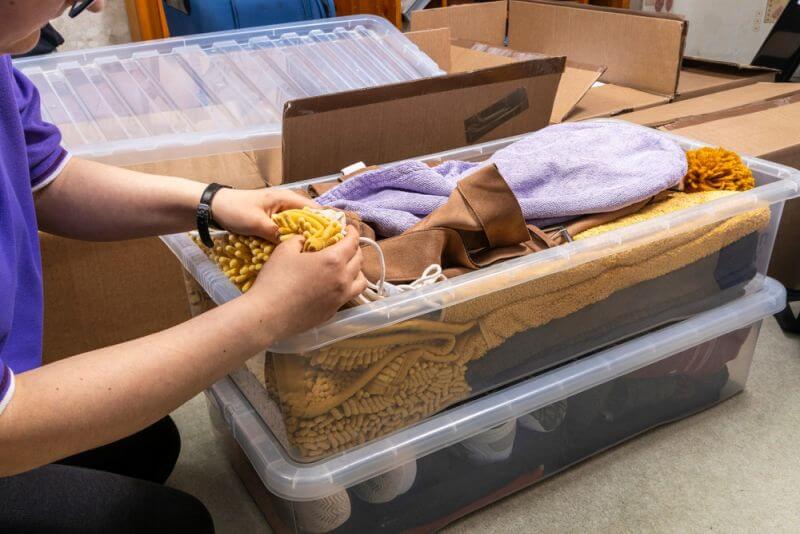These days, food supplies and other resources needed to survive and thrive are becoming unreliable. It is necessary to have hidden storage areas to keep your survival resources safe and secure from theft. With this in mind, you must build hidden storage areas that most people would not think of or find easily.
When considering hidden storage areas, it is important to know which modern technologies might reveal them. For now, be aware and try to keep up with information related to devices that can “see” through walls, oscilloscope cameras, heat, metal, and specialized detectors that can be mounted on drones.
No matter how carefully you plan to prevent detection by eye, there are many devices that others can use to find everything you own without ever entering your home. This, however, is a topic all in its own, and beyond the scope of this article. For now, let’s look at basic areas where you can hide your supplies.
Storage Areas in Your Attic
If you have an unfinished attic, it is easier to plan out all the rooms and customize the space for different storage areas. On the other hand, if you have to do certain kinds of remodeling, you may need to get a permit and then hire a contractor acceptable to the municipality.
While you are in the planning stages, consult the local and state building codes so that you can develop building plans in alignment with zoning concerns, suitable contractors, and precisely which stages you can do yourself without having legal problems. This is also the best time to make sure you know what kind of inspections will occur during and after the remodeling is done.
Depending on the shape of the building and roof design, there may be areas where no one would think to look for a hidden room in both finished and unfinished attics. Dormers, and also extensions that change the building from a rectangular shape are two examples of areas where the attic space above can serve as a hidden room.
For example, with an “L” shaped building, the attic area where the short extension is may not be easily seen, even if you are in the attic. Depending on the height of the walls, you can use storage racks or build shelves. Or, you can use water-proof storage tubs on the floor.
Another excellent location for hidden storage is under the plywood flooring on the lower side of an angled roof and the center portion of an unfinished attic. The area between the beams is very useful for lightweight items.
To keep the supplies safe from changing temperatures and humidity, all areas between the beams must have insulation below and above the recess.
If your attic is finished, carefully note closets housed under dormers or other areas. If the closet doesn’t extend all the way behind the main attic area, then you may have a viable hidden room. All you have to do is create an access point in one or both side walls of the closet. Even though this area may have little height or depth, you can still fit plastic totes and narrow, short objects in that area.
Storage Areas in Bedrooms
If you live in an older home built between the 1920s and the late 1960s, the rooms were generally more extensive and robust than those built today. As in the attic, first-floor bedroom closets may also have extra space behind them. All you have to do is make an access point from within the closet. In most cases, you won’t have to change the enclosing walls. The size of this hidden storage area depends on how the original homeowner built the walls and how much air space there is between the walls.
There is a saying you can never have too much closet space. If you are planning to add more closet space, don’t destroy the existing one. Instead, build a new one in front of it. Then, you have the entire old closet for a hidden storage area. As long as you have clothes or other items in front of it, no one will ever know it is there.
Hidden Areas Under Stairways
Suppose you have a closet on the same wall as an enclosed stairway. It would be simple to make a hidden entrance going from the side wall of the closet to under the stairway. Even without a closet, you can still make an entrance to the area under the stairs through one of the walls. To find beams and electrical wires, use an electric stud finder so that you know exactly where to cut into the wall.
In the absence of a closet where you can conceal the entranceway, keep the hatch as small as possible and close to the ground. No matter whether you put a couch or table in front of the hatchway, make sure you have furniture movers installed so that you can move it aside quickly and easily to gain access to the hidden area.
Another possibility is to carefully remove one of the top planks from the stairs and fit it with a mechanism that makes it easy to open and close the entrance. If you have carpet over the steps, you will also need to cut the carpet so that it doesn’t reveal the access point and secure it so that it doesn’t come loose during normal use.
Hidden Storage Areas in the Bathroom
Most people think a bathroom is not suitable for hidden storage areas. However, if the supplies are small, like medications or other small supplies, there are several areas that will work.
One of the best areas is under the bathtub or in the walls surrounding it. To access this area, remove the plumbing access door. All supplies stored here must be in water- and airtight containers. Depending on the age of your home, there may also be an airspace behind the linen closet that you can use for hidden storage.
Hidden Storage Areas in the Basement or Crawlspace
Before you can use the basement or crawlspace as a storage area, it must be sealed to prevent water and other leakage. If the foundation isn’t sound, you may also need to make repairs so that you don’t wind up in a situation where your hidden valuables are damaged by floor cave-ins or other problems.
After sealing the basement or crawlspace, you can make discrete storage areas along the walls and specific foundation points. For example, many foundations have concrete blocks that extend from the ground to the top of the empty space. This is the perfect area to lay in another set of blocks so that there is an enclosed space on one or both sides of the existing structure.
Be sure to conceal the entrance carefully. It is also important to consider how the foundation may settle over time. You may need to include breathing space for the blocks or take other steps to ensure the new structure doesn’t cause problems. If you have to add breathing space, you can always cover the face of the airspace with caulk and paint so that it looks like the area is fully enclosed.
To disguise the newness of the structure, take careful note of what makes the existing structures look aged. For example, if there is mud on the blocks, signs of spiders, or other debris, replicate that once you are done building.
If your basement already has sheetrock and rooms built, then you must also add sheetrock and paint to the new area. In this case, give the whole room a new coat of primer and paint so everything blends in.
Dirt crawl spaces under the house also make good hidden storage areas. With a working heating system, the temperature usually stays above freezing in the winter. In the summer, the crawl spaces remain cool. With these stable temperatures, you can bury supplies in airtight, water-proof containers.
Use house supports as reference points to know exactly where the hidden storage area is. As in a regular basement, you can also add additional concrete blocks to create hidden storage areas.
I like crawl spaces under the house because most people do not like to crawl around in dark, sometimes moist environments. Even when wearing protective clothing and boots, they are still afraid they might run into squirrels, mice, rats, snakes, and other creatures.
Choosing Entrance Coverings
If you go through all the trouble to create a secret storage area, it doesn’t make sense to put a conventional door with a lock and key on it. Some options that may work better include:
- Sliding Wall Panels
- Hatches
- fitted planks with pulleys or other gear attached to pull or push the supplies in or out of the storage area entrance.
Knowing how to create, locate, and master the art of hidden storage areas is an important skill in these times. If you take a careful look at your home and its structure, you may find areas as small as a few inches and others several feet in length, height, and depth. All of them can be used to your advantage.








Tom MacGyver | November 7, 2024
|
If you live in a hot place like the desert, I wouldn’t recommend the attic as a storage space for anything but the most hardy of items. My attic is subject to WILD temperature swings that will DESTROY many things like food items, books, and the like. Basements are better as long as they don’t flood, though you may need to run a dehumidifier down there to mitigate rot and rust. The BEST place to store your stuff is where YOU are comfortable. Temperature and humidity-stable places are ALWAYS the best places!
mark lloyd | November 7, 2024
|
Frankly there’s nothing particularly secret/unusual about any of these places/suggestions. given time, creative invaders are likely to find search out most of these places. Sorry, but that’s just the way it is. Utilizing obscure architectural spaces only works if the access is done well. Few ‘do-it-yourself’ projects embody the required skill/craftsmanship to properly hide the required access mechanisms.
Wendy Lee Holmes | November 7, 2024
|
I am an older, disabled woman with limited income. Any suggestions for me?
Ron | December 25, 2024
|
Get friends and talk about prepping with them. Convince them to plan ahead of any disaster and ask to be included in their plan. Do not hope for government help.
Terri Brouthers | November 7, 2024
|
What if you live in a double-wide mobile home?
Bejay Wye | November 7, 2024
|
Picture tells thousand words.
Vague and ambiguous to people like me.
I suspect others may be confused here